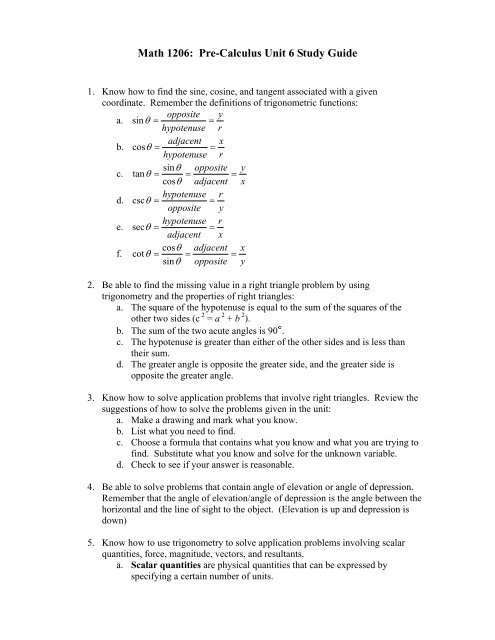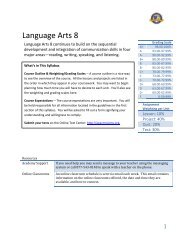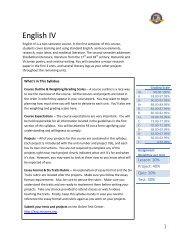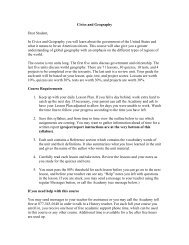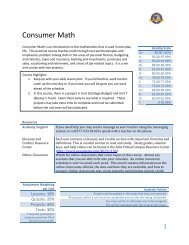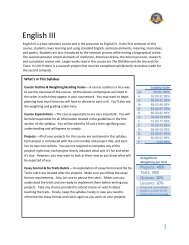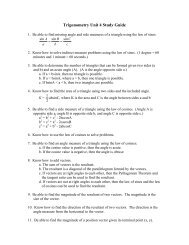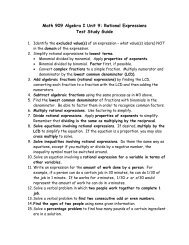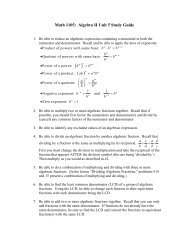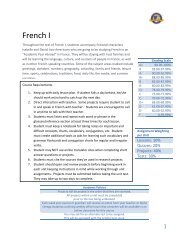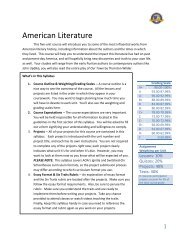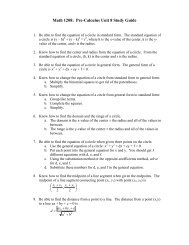Math 1202: Pre-Calculus Unit 2 Study Guide
Math 1202: Pre-Calculus Unit 2 Study Guide
Math 1202: Pre-Calculus Unit 2 Study Guide
You also want an ePaper? Increase the reach of your titles
YUMPU automatically turns print PDFs into web optimized ePapers that Google loves.
<strong>Math</strong> 1206: <strong>Pre</strong>-<strong>Calculus</strong> <strong>Unit</strong> 6 <strong>Study</strong> <strong>Guide</strong>1. Know how to find the sine, cosine, and tangent associated with a givencoordinate. Remember the definitions of trigonometric functions:a.opposite ysin θ ==hypotenuse rb.adjacent xcos θ ==hypotenuse rc.sinθopposite ytan θ = = =cosθadjacent xd.hypotenuse rcsc θ ==opposite ye.hypotenuse rsec θ ==adjacent xf.cosθadjacent xcot θ = = =sinθopposite y2. Be able to find the missing value in a right triangle problem by usingtrigonometry and the properties of right triangles:a. The square of the hypotenuse is equal to the sum of the squares of theother two sides (c 2 = a 2 + b 2 ).b. The sum of the two acute angles is 90 .c. The hypotenuse is greater than either of the other sides and is less thantheir sum.d. The greater angle is opposite the greater side, and the greater side isopposite the greater angle.3. Know how to solve application problems that involve right triangles. Review thesuggestions of how to solve the problems given in the unit:a. Make a drawing and mark what you know.b. List what you need to find.c. Choose a formula that contains what you know and what you are trying tofind. Substitute what you know and solve for the unknown variable.d. Check to see if your answer is reasonable.4. Be able to solve problems that contain angle of elevation or angle of depression.Remember that the angle of elevation/angle of depression is the angle between thehorizontal and the line of sight to the object. (Elevation is up and depression isdown)5. Know how to use trigonometry to solve application problems involving scalarquantities, force, magnitude, vectors, and resultants.a. Scalar quantities are physical quantities that can be expressed byspecifying a certain number of units.
. Force is pushing, pulling, compressing, distorting, or changing the state ormotion of a body.c. Magnitude is a scalar quantity that has the property of size and can befully described by a number.d. A vector shows the direction and the magnitude of a force.e. The resultant is the sum of two or more vectors.6. When given the two forces, be able to find the resultant and the magnitude. Theresultant force is represented by the diagonal of the parallelogram formed by theforces. The magnitude is the length of the resultant.7. When given the resultant, find the vertical and horizontal components. If isthe resultant and is the angle formed by the horizontal component and theresultant, then (horizontal component) = cos and(vertical component) = sin .8. Be able to use the Law of Cosines to find unknown sides or angles in triangles:a. a 2 = b 2 + c 2 – 2bc cos Ab. b 2 = c 2 + a 2 – 2ca cos Bc. c 2 = a 2 + b 2 – 2ab cos C9. Know how to use the Law of Sines to find unknown sides or angles in triangles:sin A sin B sin C= =a b c10. Be able to solve application problems using trigonometric functions, the Law ofSines, and the Law of Cosines. Review the steps used to solve these problems:a. Draw a diagram illustrating the problem.b. Decide which process to use (trigonometric functions, Law of Sines, orLaw of Cosines).c. Set up the equation.d. Solve the equation.11. Know how to solve application problems that involve inclined planes and forcesusing trigonometric functions and vectors.12. Understand navigation vocabulary and be able to solve problems that contain thisvocabulary:a. Air speed is the speed of an airplane in still air.b. Course is the direction of an airplane's flight path.c. Force is pushing, pulling, compressing, distorting, or otherwise changingthe state or motion of a body.d. Grade is the slope or the vertical distance divided by horizontal distance.e. Ground speed is the speed of an airplane relative to the ground or waterover which it flies.f. Heading is the direction in which an airplane is pointed.g. Head wind is a wind that blows in the direction opposite that of anairplane's flight.
h. A knot is equal to one nautical mile per hour.i. A nautical mile is a distance of 6,080.27 feet.j. A tail wind is a wind that blows in the same general direction of anairplane's flight.k. Track is the actual path of an airplane's flight.13. Be able to solve navigation problems by using trigonometry.


